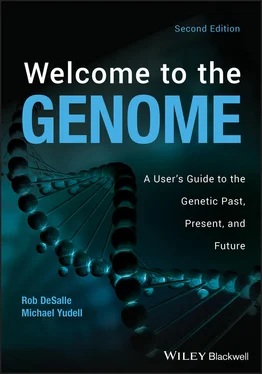What about heredity? In the most basic sense we should think about heredity as the transmission of traits from one generation to the next. When we talk about heredity in this book we refer to the ways in which traits are passed between generations via genes. The term heredity is also sometimes used to describe the transmission of cultural traits. Such traits are shared through a variety of means including laws, parental guidance, and social institutions. Unlike genetics, however, there are no physical laws governing the nature of this type of transmission.
What are genes? Genes are regions of DNA and are the basic units of inheritance in all living organisms. These words, genes and DNA, are too often used interchangeably. Both genes and DNA are components of heredity, but we identify genes by examining regions of DNA. In other words, DNA is the basic molecular ingredient of life, whereas genes are discrete components of that molecular brew.
If you look at any family you’ll see both shared and unique traits. Family members typically look alike, sharing many features such as eye color and nose shape, but they may also have very different body types and be susceptible to different diseases. This diversity is possible for two reasons. The first reason is that genes come in multiple forms. These alternative forms are known as alleles, and in sexual reproduction they are the staple of organismal diversity. According to the laws of genetics, siblings can inherit different traits from the same biological parents because there is an assortment of alleles that can be randomly passed along. The second reason is that the environment can exert a significant influence on the expression of genes. For example, an individual may inherit a gene that makes him or her susceptible to lung cancer. Such susceptibility is typically revealed, however, only after years of genetic damage caused by cigarette smoking or other lung‐related environmental impacts. (3) Recent advances in the field of epigenetics have brought new complexity to our understanding of how our genes interact with our environments, and how such interactions can be passed between generations (through the germline). Over the past decade epigenetic research has accelerated our understanding of how environmental factors can alter the peripheral structure of DNA—not the DNA sequence itself but the molecular structures that interact with and support the sequence—to elicit changes in the expression of a gene (the gene’s phenotype).
So how did science progress from thinking about the mechanisms of heredity to understanding that genes are the basic units of heredity, to deciphering and finally manipulating the DNA code that underlies all life on Earth? The results of the Human Genome Project were the fruits of over a century of struggle by scientists around the globe. Most historians of science would measure this progress beginning with Gregor Mendel’s work on pea plants during the middle of the nineteenth century. Although premodern thinkers did have a basic grasp of the idea of heredity—that is, that identifiable traits could be passed down from generation to generation—it was not until Mendel that science began to understand the mechanisms underlying the transmission of these traits. (4)
The journey from abstract notions of inheritance to the sequencing of the human genome abounds with stories of discoveries both great and small that led to where we are today. Science seldom progresses in a straight line. The genome was always there for us to find but took centuries to discover because knowledge and the technological application of that knowledge advance fitfully, revealing gradually more over time, and the social and cultural context that prioritizes different types of knowledge ebbs and flows with that time. Scientists have not always made the right choices. Even today, in what has been called the post‐genomic age, we are likely making assumptions about our genes that future generations look back on and ask, “How could they have thought that?” The trials and errors of science are part of what makes this process so interesting.
Several major building blocks of life had to be discovered to make possible our entry into the genomic world. First, scientists needed to determine what constitutes the hereditary material that passes from one generation to the next. Second, they needed to find out what constitutes the biochemical basis for the expression of this intergenerational legacy. This endeavor required the ability to take cells apart and analyze the chemical components from different parts of cells. Scientists then needed to determine the ways in which these chemicals, the building blocks of life, interacted, how they were structured, and how that structure influenced the hereditary process. Finally, technologies needed to be developed to use this information to improve human health, agriculture, and our understanding of our place in the history of life on Earth.
It took almost 150 years from the discovery of the hereditary principles to the sequencing of the human genome. The stories behind these discoveries explain how scientists came to understand the biological basis of heredity. What follows does not represent the comprehensive history of all the important genetic work of the past century or so. Yet without the discoveries we highlight, the discovery of the genome would never have occurred or would have happened very differently.
The meanings and mechanisms of heredity were pondered and debated millennia before the development of modern genetics. In the fifth century BCE, the Greek dramatist Euripides wrestled with the complexities of the relationship between parent and child in his play Electra:
I oft have seen,
One of no worth a noble father shame,
And from vile parents worthy children spring, Meanness oft groveling in the rich man’s mind, And oft exalted spirits in the poor. (5)
Without knowledge of genes or genomes, premodern thinkers had many ideas concerning the nature of heredity, some of which were surprisingly sophisticated and accurate. To Euripides heredity must have been a mystifying and seemingly random process. How else could he and his contemporaries explain the inconsistencies among inherited traits within families? Other ancients carefully considered similar questions. Lucretius, a Roman philosopher, wrote that traits could skip generations, as children sometimes resembled their grandparents. (6) Around the globe, premodern farmers had already developed sophisticated breeding techniques that depended, in part, on a basic understanding of heredity. We know, for example, that the ancient Assyrians and Babylonians artificially pollinated date palm trees and that many animals, including sheep, camels, and horses were domesticated during ancient times. (7) The domestication and breeding of plants and animals shows that many early thinkers recognized that traits were passed between generations.
Perhaps the most advanced premodern thinker on heredity was Aristotle (384–322 BCE). (8) Aristotle dedicated much of his work to questions concerning the specific mechanisms of heredity. He theorized that inherited traits were passed between generations by what he called the eidos , or the blueprint, that gave form to a developing organism. Aristotle’s eidos was entirely theoretical—he could not see this invisible configuration—a fact that makes his theory all the more remarkable. Aristotle understood the mechanisms of heredity only in the broadest sense and remained handicapped by the limited technology of his time, a primitive understanding of biology, and the cultural limitations of his worldview. Yet a keen perception, buttressed by his emphasis on observation and description, made him a brilliant interpreter of the natural world.
The concept of the eidos remained the most complete theory of heredity until the modern era of genetics. More than two millennia later scientists use a genetic language strikingly similar to Aristotle’s. The eidos is in many ways analogous to the modern concept of a genome, and like Aristotle today’s scientists often refer to a genome as a blueprint for life. (9)
Читать дальше












